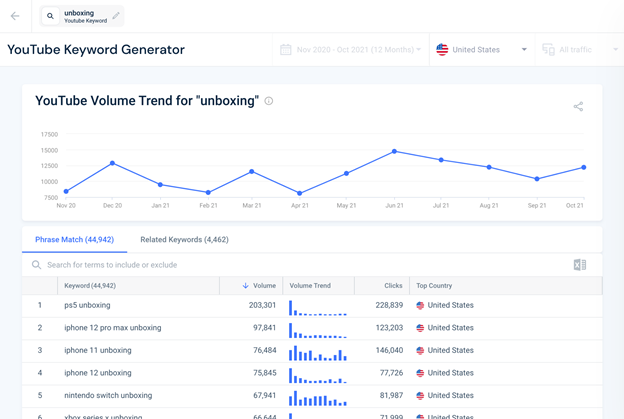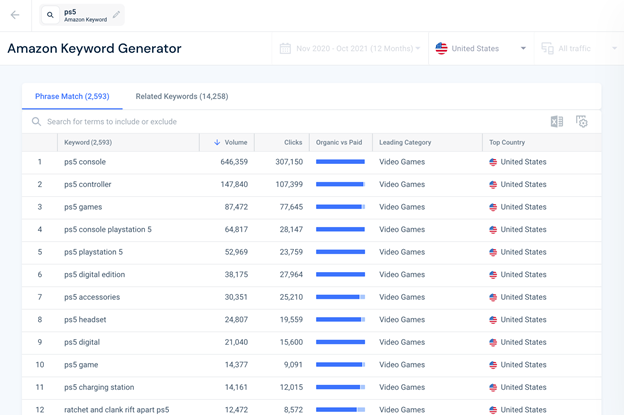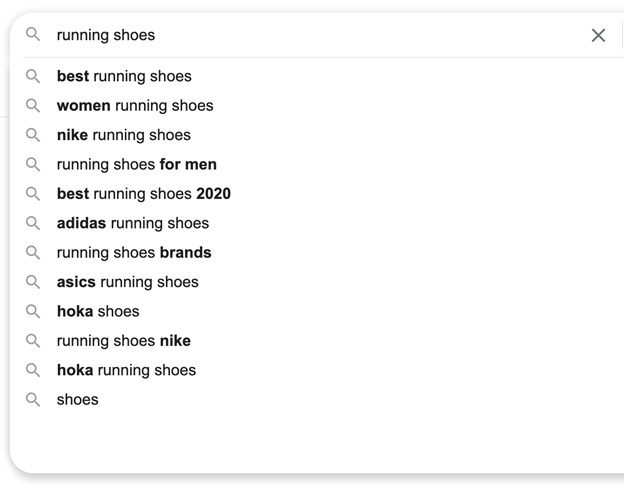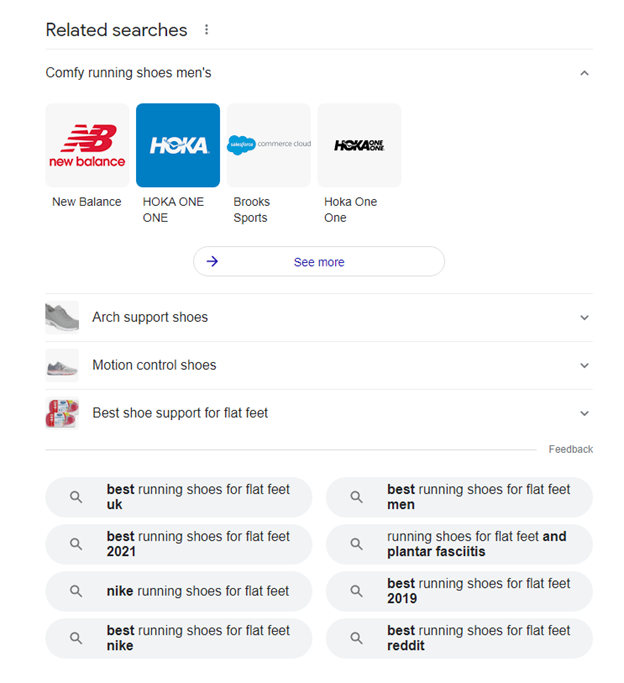This post was sponsored by Similarweb. The opinions expressed in this article are the sponsor’s own.
In the jungle of SEO, there’s a lot of competition for the best resources – keywords, backlinks, and top Google spots. Being industrious isn’t enough.
You need to hack your way through the keyword jungle and blaze new trails to locate the best, most valuable opportunities.
Okay, admittedly, it’s not always that thrilling, but you get my point.
If you want to be a pioneer in your market, a standard compass (or a standard keyword research approach) won’t be enough.
Here, I’ll guide you through seven less-explored paths to uncover the best keywords.
1. Explore Internal Site Search
One powerful method of keyword research is viewing your competitors through the eyes of their audience.
Since you and your competitor have a certain degree of audience overlap, why not use the competition’s website as a research tool?
Here’s how: Visit and explore your competitors’ websites, put yourself in the shoes of their audience, and begin using their onsite site search bar.
To do effective SEO keyword research, you need to think like the audience to tap into their search habits.
Every company’s website is set up differently, so some may suggest search terms as you type.
In this case, shell.com has “top searches” listed.
 Screenshot from shell.com January 2022
Screenshot from shell.com January 2022This gives you insight into what their visitors want to find.
You can use these terms to inform your keyword research. You can look into the keyword search volumes using a research tool.
Dig into how the website ranks for these terms to see if there are any SEO opportunities for your brand.
- Pro tip: You can repeat this process on your competitor’s Q&A page to see what question queries are relevant to your audience.
As you voyage through the rest of the website, get more insights by asking yourself:
- How is this site positioning itself to its audience?
- What keywords keep coming up?
- Where is the website funneling you? And how do the keywords fit in?
2. Hunt For Backlinks & Anchor Text
I know what you’re thinking, anchor text can consist of duplications and noise like “click here.”
And you’re right, but it’s also an indicator of how people describe what they are linking.
Here’s how: If you look closely at the URL slug and the linked text, you’ll discover some pre-researched keywords within them.
Try to spot the two keywords in the URL below:
<a href=”https://www.esquire.com/style/mens-fashion/a37755426/squid-game-costume/”>Squid Game Jumpsuit</a>
Did you find them?
Check yourself. They are highlighted below.
- <a href=”https://www.esquire.com/style/mens-fashion/a37755426/squid-game-costume/”>Squid Game Jumpsuit</a>
- <a href=”https://www.esquire.com/style/mens-fashion/a37755426/squid-game-costume/”>Squid Game Jumpsuit</a>
If you were doing keyword research for an ecommerce site that sells “Squid Game” themed attire, you’d want to include the terms “Squid Game costume” and “Squid Game jumpsuit” in your target keyword list.
- Pro tip: Use the terms you find this way in your keyword research, too. They might lead you to other variations in relevant terms you haven’t yet considered. People’s search habits are unpredictable.
3. Dive Into Keywords By Industry
High-value, industry-level keywords are influenced by events, trends, time of year, holidays, news stories, and other real-life factors such as new product releases from brands in your industry.
Here’s how: Keep your finger on the pulse of what’s happening in your industry and leverage that information for your keyword research.
When you have access to fresh and accurate digital data, you can understand which keywords are making a splash in your industry and locate the strongest terms before your competitors.
With Similarweb Digital Marketing Intelligence, you can filter this information by the last 28 days to see the latest keyword trends or select “trending terms” to get insight into which terms drove traffic the previous month.
Then, sort by descending traffic or percent change to see who the biggest movers are in your industry.
You can also discover newly trending search terms.
 Screenshot from Similarweb Website Intelligence, TV, Movies, and Stream Keywords by Industry, January 2021
Screenshot from Similarweb Website Intelligence, TV, Movies, and Stream Keywords by Industry, January 2021- Pro tip: Filter by “newly discovered” to see search terms that didn’t appear the previous month that are currently driving traffic – one potential keyword goldmine.
4. Venture Beyond Google’s Data
In reality, people turn to different search engines for different needs.
Don’t overlook the wide influence of Amazon and YouTube when embarking on your keyword research journey.
By uncovering search engine-specific keyword data and search intent, you can identify more opportunities to reach your target audience, no matter where they are searching.
Here’s how: Search for potential keywords on Google, then Amazon, then YouTube to better understand your audience’s needs and intent.
Similarweb gives you unrivaled data from the three biggest search engines in the world, amazon.com. google.com, and youtube.com.
Let’s go deeper and compare YouTube and Amazon for “ps5” related keywords.
On youtube.com, “ps5 unboxing” is a trending keyword.
Phrase match terms include “iphone 11 unboxing” and “nintendo switch unboxing.”
All these terms primarily lead to informational content about what happens when you “unbox” or open your product. This can include videos, vlogs, and reviews.
 Screenshot from Similarweb Website Intelligence, unboxing search in the YouTube Keyword Generator, January 2021
Screenshot from Similarweb Website Intelligence, unboxing search in the YouTube Keyword Generator, January 2021On amazon.com, phrase match keywords for “ps5” include “ps5 controller,” “ps5 games,” and “ps5 headset.”
These terms indicate high transaction intent. People are primarily searching for related products.
Analyzing the related keywords on amazon.com can help you get a better understanding of other topics and products your target audience is interested in so you can incorporate those terms into your strategy as well.
 Screenshot from Similarweb Website Intelligence, ps5 search in the Amazon Keyword Generator, January 2021
Screenshot from Similarweb Website Intelligence, ps5 search in the Amazon Keyword Generator, January 2021Using Similarweb for both platforms, you can click on the specific keywords to get data on the search volume, clicks, organic vs. paid, and other metrics.
5. Unearth Terms With Autocomplete
Have you ever noticed that when you start entering a query into Google, the search engine suggests what you should search?
For example, if you start typing “running shoes,” Google may suggest you search “running shoes for men,” “running shoes for flat feet,” and other related queries.
Google’s autofill makes those suggestions because those are all related queries of interest to many searchers.
 Screenshot from a Google search for running shoes, January 2021
Screenshot from a Google search for running shoes, January 2021Why does that matter?
These autocomplete words and phrases open a portal into how people are searching for these keyword phrases.
Bottom line: This gives you the intel to speak the same language as your keyword audience.
This could lead you to potential long-tail keywords that you hadn’t thought of before and guide your long-tail keyword strategy.
Here’s how: Simply look up a search term and see how Google’s Autocomplete assistant finishes your phrase.
But remember, only harness the power of the keywords that actually make sense for your target audience and your website. You don’t want to get pulled in the wrong direction by following irrelevant keywords.
6. Navigate Google’s SERP Features
Yes, you read that right. Google is on this list twice and, no, it’s not a mistake. Google’s featured data can also be used to inform your SEO strategy.
Here’s how: Before you leave the popular search engine check out Google’s “people also ask” and “related search” features.
Both are invaluable resources and give you different ideas than Google’s Autocomplete functionality, so don’t skip this step.
These features show you what questions people ask surrounding your topic and other related searches.
This tool provides insight into your target audience’s interests and search intent.
In our previous “running shoe” example, the “people also ask” section reveals two very different search intentions.
- The first is informational intent and appears to be a searcher looking for information on running with flat feet.
- The second is transactional intent – the searcher is researching what shoe would be best to buy.
You may consider creating content around both of these long-tail keywords to reach two different audiences.
 Screenshot of the “people also ask” SERP feature for a Google search of running shoes, January 2021
Screenshot of the “people also ask” SERP feature for a Google search of running shoes, January 2021When we check out “related searches,” we can see many searchers are specifically looking at Nike for running shoes.
Knowing that might lead you to investigate Nike’s keyword strategy in more detail to understand how they are reaching their audience and inform your research.
 Screenshot of the” Related searches” SERP feature for a Google search of running shoes, January 2021
Screenshot of the” Related searches” SERP feature for a Google search of running shoes, January 20217. Dig Into Competitor Metadata
This is one of the best keyword research hacks.
It’s particularly effective when analyzing smaller, specialist websites, but it can be used for large websites. Plus, it’s so simple.
Here’s how: All you have to do is check out your competitors’ sites and ask yourself what keywords your competitors use in their titles.
How your competitors position themselves will be revealed by their language.
Let’s look at an example.
Notice how tui.co.uk’s page navigation is set up?
 Screenshot of tui.co.uk, January 2021
Screenshot of tui.co.uk, January 2021It’s clear from tui.co.uk’s homepage that holidays, flights, and cruises are areas of focus for them based on their website content structure.
These offerings are highlighted multiple times and each has accompanying dropdown menus, meaning they are content-heavy topics on TUI’s website.
If you were in competition with TUI for organic traffic, this insight would guide the types of long-tail keywords you could use to grab more market share.
Track Your Journey
There are tried and true ways to find great keywords. But, every SEO professional is trekking through those paths.
To find uncommon keywords that will put you ahead of your SEO competitors and boost your market share, you need the latest techniques, the most up-to-date data, and actionable insights to properly create a keyword strategy.
As you map your 2022 strategy, use Similarweb as your compass and craft a data-driven action plan. Let’s make a real business impact.
Image Credits
Featured Image: Image by SimilarWeb. Used with permission.






